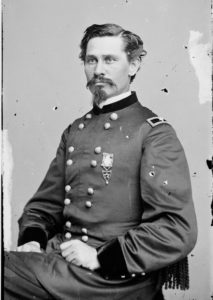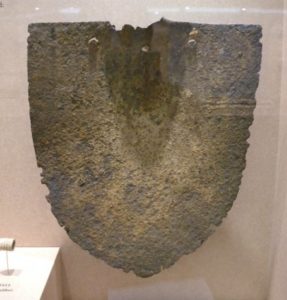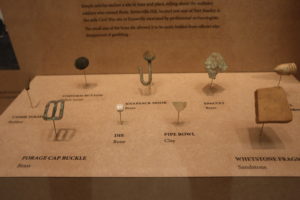“The topographical features of the vicinity of Knoxville give that place decided strength as a military position.” – Captain Orlando Poe, Official Records of the War of the Rebellion, Vol. 31

CAPTAIN ORLANDO METCALFE POE (1832-1895) 1861-1865 Original in the Library of Congress Orlando M. Poe was an 1856 graduate of West Point. He had arrived in Knoxville with Burnside in September and knew the area well by November. His ability to organize people and to execute a brilliant plan of defenses in a few days ensured that the very best of the Confederate army would fail to take Knoxville. In April 1864, Poe became Gen. T. Sherman’s Chief Engineer during the Atlanta Campaign and the famous ‘March to the Sea.’ By the war’s end, he had been promoted to general.
As two great armies converged on the town, nobody knew how soon and from where the attack would come. The defenses had to be designed and constructed to hold at every point and from every direction.
Beginning November 16, Poe pressed all able-bodied men into service: soldiers, civilians, and “contrabands,” the nearly 200 African Americans who had been slaves. These last, Poe praised:
“…I feel it my duty to refer to the great value of the services of the contrabands. Tractable and willing (many of them came to me and volunteered to work), they did an amount of work which was truly astonishing. Day and night they worked without a murmur. For the first week they labored regularly eighteen hours out of the twenty-four…” Official Records of the War of the Rebellion, Vol. 31
Poe’s wide-ranging preparations included:
- A pontoon bridge, transported from Loudon and installed on the Holston River, now the Tennessee River;
- Construction of batteries and/or rifle-trenches on four hilltops south of the river;
- Eight batteries and five forts, and more than seven miles of rifle-trenches connecting them north of the river;
- Dams on First and Second Creeks to create impassible 5’ deep ponds on the north side;
- Interior rifle-trenches and earthworks on the heights at the University (Fort Byington) and east of Temperance and Flint Hills to back up the main line;
- Abattis, sharpened branches and logs, and 5-foot spear-like weapons called pikes facing outward at various points on the line;
- Telegraph communication all along the defensive perimeter and to Burnside’s headquarters on Gay Street.
Both sides knew Fort Sanders itself was the weakest part of the whole line. Poe strengthened it by:
- Placing troops and artillery to compensate for the “sector without fire,” an area in front of the northwest bastion the cannons could not cover;
- Stringing telegraph wire stump to stump in front of the trenches at Fort Sanders and other locations;
- Plowing furrows along the hillside in front of the rifle-pits;
- Eliminating a step-like feature called the berme at the base of the parapet inside the ditch;
- and piling cotton bales covered with nonflammable fresh cow hides on top of the parapet to make the walls even higher.
During a siege, with no incoming supplies, inventive uses must be made of materials on hand. Telegraph wire proved especially adaptable. This may be the first time wire was strung from stump to stump to trip up attacking infantry.
Iron wire anchored the boom cable Poe stretched across the Holston River to protect the pontoon bridge from possible Confederate ramming rafts. Wire also held outward-facing pikes together, creating a deadly 5-foot obstacle for a charging enemy.

FORT STANLEY 1864 Original in the Library of Congress This detail of a larger George Barnard photograph shows the simple shelters with walls and chimneys that Union troops built to endure an East Tennessee winter.
Up Next: Wheeler’s Calvary Attack

SHOVEL BLADE, Civil War period, from Dalton, GA
Iron, Museum purchase
“Captain Poe had before leaving Kentucky organized an engineer battalion from the 23rd Corps, and had by great efforts succeeded in bringing over the mountains a quantity of entrenching and other engineer tools. These proved to be of greatest possible value to us during the siege.” Gen. Ambrose Burnside from the Official Records of the War of the Rebellion, Vol. 31

CAMP ARTIFACTS, 1863-1865
Excavated in 1992 by University of Tennessee archaeologist
Loaned by Archaeological Research Laboratory, UT Simple articles anchor a site in time and place, telling about the ordinary soldiers who owned them. Sevierville Hill, located just east of Fort Stanley, is the only Civil War site in Knoxville excavated by professional archaeologists. The small size of the bone die allowed it to be easily hidden from officers who disapproved of gambling.
- COMB TOOTH / Rubber
- DIE / Bone
- EPAULET / Brass
- FORAGE CAP BUCKLE / Brass
- KNAPSACK HOOK / Brass
- MINIE BALL / .577-.58 caliber / Lead
- PIPE BOWL / Clay
- UNIFORM BUTTON / Yellow metal
- WHETSTONE FRAGMENT / Sandstone
